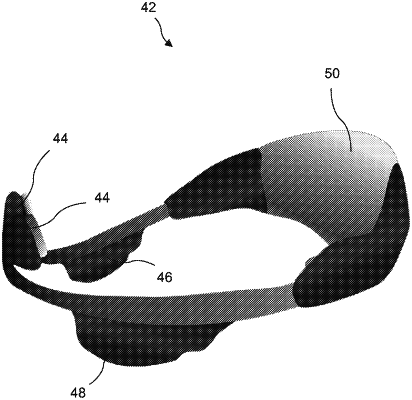| CPC A61H 23/02 (2013.01) [A61H 2201/165 (2013.01); A61H 2201/1611 (2013.01); A61H 2201/501 (2013.01); A61H 2201/5071 (2013.01); A61H 2205/04 (2013.01)] | 13 Claims |

|
1. A method of vibrationally exciting a laryngeal nerve to treat at least one of a swallow disorder, a voice disorder, or chronic cough, the method comprising:
providing a laryngeal nerve exciter system comprising:
a neckband, the neckband comprising a first free end and a second free end opposing each other to form an open front, the first free end and the second free end spaced apart by a distance, the neckband being flexible to accommodate necks of different sizes, the neckband further comprising a center portion facing the open front, a first side portion and a second side portion disposed on opposite sides of the center portion,
a first exciter extending from the first free end of the neckband, the first exciter disposed between the first free end and the first side portion, the first exciter comprising a first surface coupled to the first free end of the neckband and a second surface opposing the first surface,
a second exciter extending from the second free end of the neckband, the second exciter disposed between the second free end and the second side portion, the second exciter comprising a first surface coupled to the second free end of the neckband and a second surface opposing the first surface of the second exciter, and
a first electrical circuit and a second electrical circuit configured to respectively control the first exciter and the second exciter,
wherein each of the first side portion and the second side portion comprises a first region and a second region closer to the center portion than the first region, wherein each first region comprises a housing mounted thereon and respectively accommodating the first electrical circuit or the second electrical circuit, and wherein each first region is larger in size than each second region due to the housing;
coupling a first adhesive pad and a second adhesive pad respectively to the first exciter and the second exciter, each of the first adhesive pad and the second adhesive pad comprising a first surface coupled to the second surface of the corresponding first exciter or the second exciter and a second surface opposing the first surface of the corresponding adhesive pad, the second surfaces of the first adhesive pad and the second adhesive pad being adhesive;
widening the distance between the first free end and the second free end of the neckband;
placing the neckband at least partially around a neck of a patient such that:
the center portion of the neckband is placed on a rear portion of the neck while the distance is widened to a first distance, and
the first free end, the second free end, and the open front of the neckband face a front portion of the neck of the patient while the first distance is narrowed to a second distance less than the first distance;
moving the neckband such that:
the first adhesive pad and the second adhesive pad are respectively positioned against a first portion and a second portion of the patient's neck different from each other;
the open front of the neckband exposes the patient's throat; and
the second surfaces of the first adhesive pad and the second adhesive pad fix positions of the neckband by adhering to the patient's skin; and
vibrationally exciting the laryngeal nerve of the patient to treat at least one of the swallow disorder, the voice disorder, or chronic cough, the vibrationally exciting including generating vibration, by the first exciter and the second exciter, and conducting, by the first exciter and the second exciter, the generated vibration to the patient's neck.
|